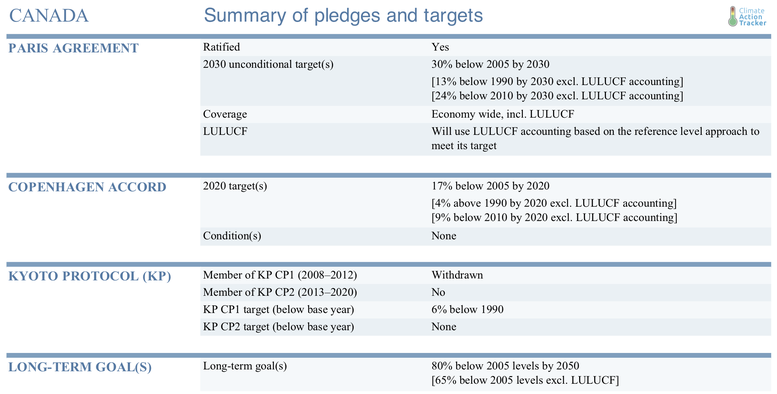Pledges And Targets
Summary table

Paris Agreement targets
Canada states in its NDC that it will pursue an economy-wide target to reduce GHG emissions to 30% below 2005 levels by 2030. A 30% reduction of 2005 levels excluding LULUCF equates to 511 MtCO2e and is equivalent to a 15% reduction below 1990. Canada intends to use 15 MtCO2e of LULUCF credits towards meeting its contribution (Environment and Climate Change Canada, 2020a). When credits from LULUCF accounting are excluded, Canada’s total emissions in 2030 would be 526 MtCO2e, which represents a 28% reduction below 2005 levels or a 13% reduction below 1990 levels. This target emissions level corresponds to a CAT rating of “Insufficient.”
It is worth noting that Canada uses “the IPCC production approach” to account for Harvested Wood Products (HWPs). Under this approach, emissions associated with wood from forest harvest and conversion activities are included in the country’s GHG inventory, irrespective of whether the products stay within the country or are exported. Accounting for HWPs must be performed in a consistent and compatible manner across countries so that accounting of imported and exported HWPs is complete, and emissions are not excluded from inventories (Macey, Hare, & Chen, 2011). Canada excludes emissions from natural disturbances (e.g. forest fires and insect outbreaks).
Canada has indicated that it may use international credits to meet its target (Carr, 2018). It has included 13 MtCO2e in credits from the Western Climate Initiative into its planned policies projections for 2030 and is part of the World Bank’s Transformative Carbon Asset Facility, an initiative aimed at a piloting carbon market mechanism under Article 6 of the Paris Agreement (World Bank, n.d.).
During the 2019 federal election, the government promised that it would ‘exceed’ its NDC if re-elected (Liberal Party of Canada, 2019b); although current projections show that the government must scale up climate action if it intends to keep that promise.
2020 pledge and Kyoto Protocol
Canada's Kyoto Protocol target for the first commitment period 2008–2012 was a reduction of 6% below 1990 levels. However, Canada withdrew from the Kyoto Protocol in December 2011.
Canada's Copenhagen pledge aims to reduce emissions by 17% below 2005 levels by 2020. The Copenhagen pledge aligned Canada’s level of ambition to the United States, which also has a target of 17% reduction in emissions from 2005 levels by 2020. The contribution from LULUCF accounting towards meeting this target is 23 MtCO2e. When credits from LULUCF accounting are excluded, Canada’s total emissions in 2020 would be 629 MtCO2e, which represents a 14% reduction below 2005 levels or a 4% increase above 1990 levels.
Long-term goal
In 2016, Canada proposed a mid-century, long-term low greenhouse gas development strategy (Government of Canada, 2016a). This strategy contains an emissions reduction pathway that is consistent with net emissions falling by 80% in 2050 from 2005 levels. The strategy documentation indicates that this target equates to a 65% reduction in emissions below 2005 levels excluding LULUCF, with the remainder to be achieved through sequestration in the land sector and international credits (Government of Canada, 2016a).
In 2019, the government adopted a 2050 target of net zero emissions; however it has yet to enshrine that target into law or establish binding five-year milestones to achieve it, as promised (Governor General of Canada, 2019; Liberal Party of Canada, 2019b). As there are no details on the extent to which the government plans to rely on the land sector to meet this net zero goal, we have analysed the long-term target as described in its mid-century strategy.
Further analysis
Latest publications
Stay informed
Subscribe to our newsletter




